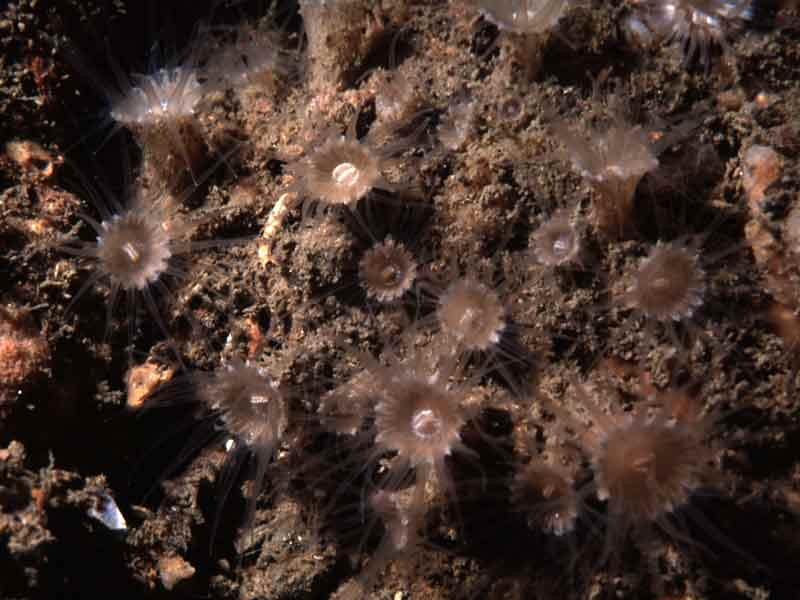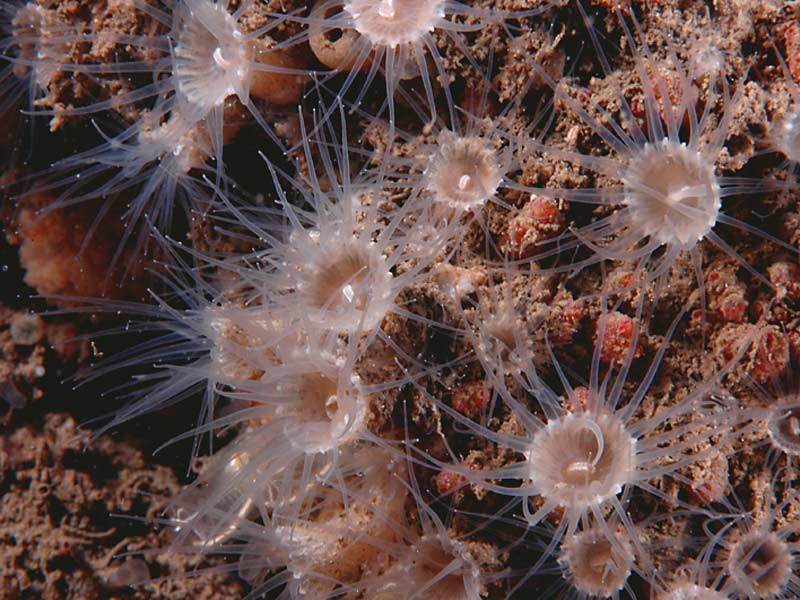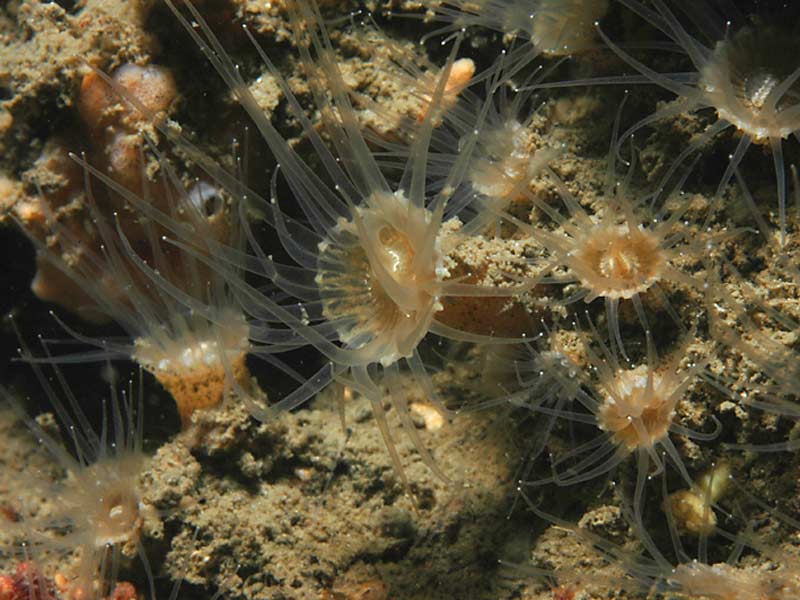Sandy creeplet (Epizoanthus couchii)
Distribution data supplied by the Ocean Biodiversity Information System (OBIS). To interrogate UK data visit the NBN Atlas.Map Help
| Researched by | Hugh Jones | Refereed by | Admin |
| Authority | (Johnston in Couch, 1844) | ||
| Other common names | - | Synonyms | - |
Summary
Description
Polyps are variable in size, up to 12 mm long and 4 mm in diameter. There are 12-16 well defined marginal teeth. Polyps arise from a stolon-like band of tissue. Tentacles number between 24-32 but 28 is typical. The tentacles are long in extension and taper evenly to their tips, each of which bears a tiny but distinct terminal knob. The disc and tentacles are colourless, sometimes freckled. The column maybe whitish, buff or pink. The species is often covered in a fine layer of sand which can cover the stolon, the lower parts of the column, and extend upwards to the marginal teeth.
Recorded distribution in Britain and Ireland
Common around the western and southern coasts of Britain it remains unrecorded in the North sea. Epizoanthus couchii also been recorded in southern Ireland.Global distribution
Reported from the coasts of northern France, Germany and Norway.Habitat
Encrusting on rocks and shells from low water of spring tide level to 100 m depth often overgrown by other species and easily overlooked when its polyps are retracted. Common in habitats subject to moderate tidal streams and some sediment scour.Depth range
-Identifying features
- Colonial habit, polyps usually arising from a narrow basal band.
- 24-32 tentacles, transparent with white tip.
Additional information
No text entered
Listed by
- none -
Bibliography
Bruce, J.R., Colman, J.S. & Jones, N.S., 1963. Marine fauna of the Isle of Man. Liverpool: Liverpool University Press.
Howson, C.M. & Picton, B.E., 1997. The species directory of the marine fauna and flora of the British Isles and surrounding seas. Belfast: Ulster Museum. [Ulster Museum publication, no. 276.]
JNCC (Joint Nature Conservation Committee), 1999. Marine Environment Resource Mapping And Information Database (MERMAID): Marine Nature Conservation Review Survey Database. [on-line] http://www.jncc.gov.uk/mermaid
Manuel, R.L., 1988. British Anthozoa. Synopses of the British Fauna (New Series) (ed. D.M. Kermack & R.S.K. Barnes). The Linnean Society of London [Synopses of the British Fauna No. 18.]. DOI https://doi.org/10.1002/iroh.19810660505
Ryland, J.S., 2000. Reproduction in British zoanthids, and an unusual process in Parazoanthus anguicomus. Journal of the Marine Biological Association of the United Kingdom, 80, 943-944.
Datasets
Centre for Environmental Data and Recording, 2018. Ulster Museum Marine Surveys of Northern Ireland Coastal Waters. Occurrence dataset https://www.nmni.com/CEDaR/CEDaR-Centre-for-Environmental-Data-and-Recording.aspx accessed via NBNAtlas.org on 2018-09-25.
Manx Biological Recording Partnership, 2022. Isle of Man historical wildlife records 1990 to 1994. Occurrence dataset:https://doi.org/10.15468/aru16v accessed via GBIF.org on 2024-09-27.
NBN (National Biodiversity Network) Atlas. Available from: https://www.nbnatlas.org.
OBIS (Ocean Biodiversity Information System), 2025. Global map of species distribution using gridded data. Available from: Ocean Biogeographic Information System. www.iobis.org. Accessed: 2025-08-08
Citation
This review can be cited as:
Last Updated: 17/04/2008





